Yan Yan
Distill Video Datasets into Images
Dec 16, 2025Abstract:Dataset distillation aims to synthesize compact yet informative datasets that allow models trained on them to achieve performance comparable to training on the full dataset. While this approach has shown promising results for image data, extending dataset distillation methods to video data has proven challenging and often leads to suboptimal performance. In this work, we first identify the core challenge in video set distillation as the substantial increase in learnable parameters introduced by the temporal dimension of video, which complicates optimization and hinders convergence. To address this issue, we observe that a single frame is often sufficient to capture the discriminative semantics of a video. Leveraging this insight, we propose Single-Frame Video set Distillation (SFVD), a framework that distills videos into highly informative frames for each class. Using differentiable interpolation, these frames are transformed into video sequences and matched with the original dataset, while updates are restricted to the frames themselves for improved optimization efficiency. To further incorporate temporal information, the distilled frames are combined with sampled real videos from real videos during the matching process through a channel reshaping layer. Extensive experiments on multiple benchmarks demonstrate that SFVD substantially outperforms prior methods, achieving improvements of up to 5.3% on MiniUCF, thereby offering a more effective solution.
Consistent Instance Field for Dynamic Scene Understanding
Dec 16, 2025Abstract:We introduce Consistent Instance Field, a continuous and probabilistic spatio-temporal representation for dynamic scene understanding. Unlike prior methods that rely on discrete tracking or view-dependent features, our approach disentangles visibility from persistent object identity by modeling each space-time point with an occupancy probability and a conditional instance distribution. To realize this, we introduce a novel instance-embedded representation based on deformable 3D Gaussians, which jointly encode radiance and semantic information and are learned directly from input RGB images and instance masks through differentiable rasterization. Furthermore, we introduce new mechanisms to calibrate per-Gaussian identities and resample Gaussians toward semantically active regions, ensuring consistent instance representations across space and time. Experiments on HyperNeRF and Neu3D datasets demonstrate that our method significantly outperforms state-of-the-art methods on novel-view panoptic segmentation and open-vocabulary 4D querying tasks.
From Particles to Fields: Reframing Photon Mapping with Continuous Gaussian Photon Fields
Dec 13, 2025Abstract:Accurately modeling light transport is essential for realistic image synthesis. Photon mapping provides physically grounded estimates of complex global illumination effects such as caustics and specular-diffuse interactions, yet its per-view radiance estimation remains computationally inefficient when rendering multiple views of the same scene. The inefficiency arises from independent photon tracing and stochastic kernel estimation at each viewpoint, leading to inevitable redundant computation. To accelerate multi-view rendering, we reformulate photon mapping as a continuous and reusable radiance function. Specifically, we introduce the Gaussian Photon Field (GPF), a learnable representation that encodes photon distributions as anisotropic 3D Gaussian primitives parameterized by position, rotation, scale, and spectrum. GPF is initialized from physically traced photons in the first SPPM iteration and optimized using multi-view supervision of final radiance, distilling photon-based light transport into a continuous field. Once trained, the field enables differentiable radiance evaluation along camera rays without repeated photon tracing or iterative refinement. Extensive experiments on scenes with complex light transport, such as caustics and specular-diffuse interactions, demonstrate that GPF attains photon-level accuracy while reducing computation by orders of magnitude, unifying the physical rigor of photon-based rendering with the efficiency of neural scene representations.
VGent: Visual Grounding via Modular Design for Disentangling Reasoning and Prediction
Dec 11, 2025Abstract:Current visual grounding models are either based on a Multimodal Large Language Model (MLLM) that performs auto-regressive decoding, which is slow and risks hallucinations, or on re-aligning an LLM with vision features to learn new special or object tokens for grounding, which may undermine the LLM's pretrained reasoning ability. In contrast, we propose VGent, a modular encoder-decoder architecture that explicitly disentangles high-level reasoning and low-level bounding box prediction. Specifically, a frozen MLLM serves as the encoder to provide untouched powerful reasoning capabilities, while a decoder takes high-quality boxes proposed by detectors as queries and selects target box(es) via cross-attending on encoder's hidden states. This design fully leverages advances in both object detection and MLLM, avoids the pitfalls of auto-regressive decoding, and enables fast inference. Moreover, it supports modular upgrades of both the encoder and decoder to benefit the whole system: we introduce (i) QuadThinker, an RL-based training paradigm for enhancing multi-target reasoning ability of the encoder; (ii) mask-aware label for resolving detection-segmentation ambiguity; and (iii) global target recognition to improve the recognition of all the targets which benefits the selection among augmented proposals. Experiments on multi-target visual grounding benchmarks show that VGent achieves a new state-of-the-art with +20.6% F1 improvement over prior methods, and further boosts gIoU by +8.2% and cIoU by +5.8% under visual reference challenges, while maintaining constant, fast inference latency.
TraceFlow: Dynamic 3D Reconstruction of Specular Scenes Driven by Ray Tracing
Dec 10, 2025Abstract:We present TraceFlow, a novel framework for high-fidelity rendering of dynamic specular scenes by addressing two key challenges: precise reflection direction estimation and physically accurate reflection modeling. To achieve this, we propose a Residual Material-Augmented 2D Gaussian Splatting representation that models dynamic geometry and material properties, allowing accurate reflection ray computation. Furthermore, we introduce a Dynamic Environment Gaussian and a hybrid rendering pipeline that decomposes rendering into diffuse and specular components, enabling physically grounded specular synthesis via rasterization and ray tracing. Finally, we devise a coarse-to-fine training strategy to improve optimization stability and promote physically meaningful decomposition. Extensive experiments on dynamic scene benchmarks demonstrate that TraceFlow outperforms prior methods both quantitatively and qualitatively, producing sharper and more realistic specular reflections in complex dynamic environments.
GLaD: Geometric Latent Distillation for Vision-Language-Action Models
Dec 10, 2025Abstract:Most existing Vision-Language-Action (VLA) models rely primarily on RGB information, while ignoring geometric cues crucial for spatial reasoning and manipulation. In this work, we introduce GLaD, a geometry-aware VLA framework that incorporates 3D geometric priors during pretraining through knowledge distillation. Rather than distilling geometric features solely into the vision encoder, we align the LLM's hidden states corresponding to visual tokens with features from a frozen geometry-aware vision transformer (VGGT), ensuring that geometric understanding is deeply integrated into the multimodal representations that drive action prediction. Pretrained on the Bridge dataset with this geometry distillation mechanism, GLaD achieves 94.1% average success rate across four LIBERO task suites, outperforming UniVLA (92.5%) which uses identical pretraining data. These results validate that geometry-aware pretraining enhances spatial reasoning and policy generalization without requiring explicit depth sensors or 3D annotations.
MVI-Bench: A Comprehensive Benchmark for Evaluating Robustness to Misleading Visual Inputs in LVLMs
Nov 18, 2025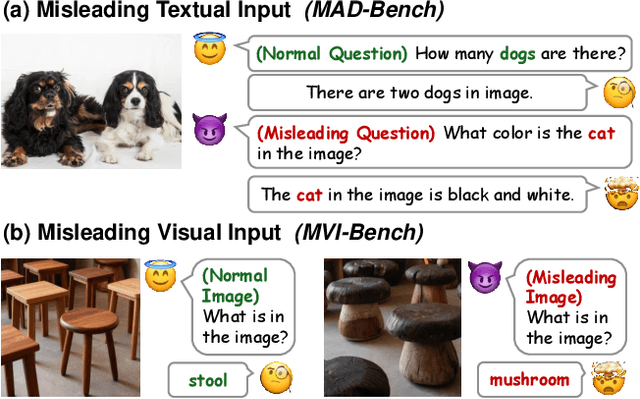

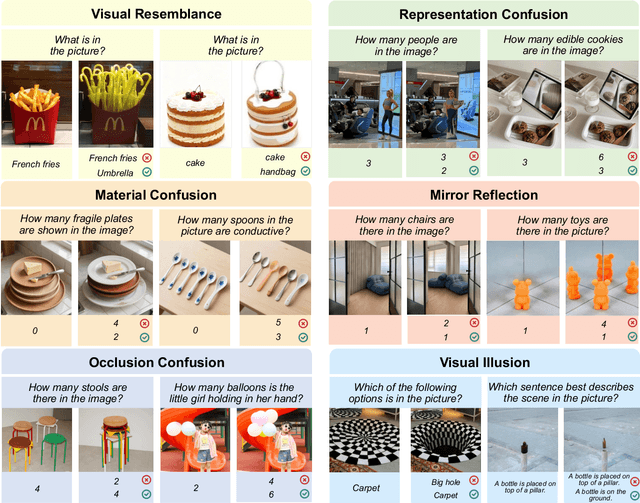

Abstract:Evaluating the robustness of Large Vision-Language Models (LVLMs) is essential for their continued development and responsible deployment in real-world applications. However, existing robustness benchmarks typically focus on hallucination or misleading textual inputs, while largely overlooking the equally critical challenge posed by misleading visual inputs in assessing visual understanding. To fill this important gap, we introduce MVI-Bench, the first comprehensive benchmark specially designed for evaluating how Misleading Visual Inputs undermine the robustness of LVLMs. Grounded in fundamental visual primitives, the design of MVI-Bench centers on three hierarchical levels of misleading visual inputs: Visual Concept, Visual Attribute, and Visual Relationship. Using this taxonomy, we curate six representative categories and compile 1,248 expertly annotated VQA instances. To facilitate fine-grained robustness evaluation, we further introduce MVI-Sensitivity, a novel metric that characterizes LVLM robustness at a granular level. Empirical results across 18 state-of-the-art LVLMs uncover pronounced vulnerabilities to misleading visual inputs, and our in-depth analyses on MVI-Bench provide actionable insights that can guide the development of more reliable and robust LVLMs. The benchmark and codebase can be accessed at https://github.com/chenyil6/MVI-Bench.
WarpGAN: Warping-Guided 3D GAN Inversion with Style-Based Novel View Inpainting
Nov 11, 2025Abstract:3D GAN inversion projects a single image into the latent space of a pre-trained 3D GAN to achieve single-shot novel view synthesis, which requires visible regions with high fidelity and occluded regions with realism and multi-view consistency. However, existing methods focus on the reconstruction of visible regions, while the generation of occluded regions relies only on the generative prior of 3D GAN. As a result, the generated occluded regions often exhibit poor quality due to the information loss caused by the low bit-rate latent code. To address this, we introduce the warping-and-inpainting strategy to incorporate image inpainting into 3D GAN inversion and propose a novel 3D GAN inversion method, WarpGAN. Specifically, we first employ a 3D GAN inversion encoder to project the single-view image into a latent code that serves as the input to 3D GAN. Then, we perform warping to a novel view using the depth map generated by 3D GAN. Finally, we develop a novel SVINet, which leverages the symmetry prior and multi-view image correspondence w.r.t. the same latent code to perform inpainting of occluded regions in the warped image. Quantitative and qualitative experiments demonstrate that our method consistently outperforms several state-of-the-art methods.
Efficient Multimodal Dataset Distillation via Generative Models
Sep 18, 2025Abstract:Dataset distillation aims to synthesize a small dataset from a large dataset, enabling the model trained on it to perform well on the original dataset. With the blooming of large language models and multimodal large language models, the importance of multimodal datasets, particularly image-text datasets, has grown significantly. However, existing multimodal dataset distillation methods are constrained by the Matching Training Trajectories algorithm, which significantly increases the computing resource requirement, and takes days to process the distillation. In this work, we introduce EDGE, a generative distillation method for efficient multimodal dataset distillation. Specifically, we identify two key challenges of distilling multimodal datasets with generative models: 1) The lack of correlation between generated images and captions. 2) The lack of diversity among generated samples. To address the aforementioned issues, we propose a novel generative model training workflow with a bi-directional contrastive loss and a diversity loss. Furthermore, we propose a caption synthesis strategy to further improve text-to-image retrieval performance by introducing more text information. Our method is evaluated on Flickr30K, COCO, and CC3M datasets, demonstrating superior performance and efficiency compared to existing approaches. Notably, our method achieves results 18x faster than the state-of-the-art method.
Investigating the Design Space of Visual Grounding in Multimodal Large Language Model
Aug 11, 2025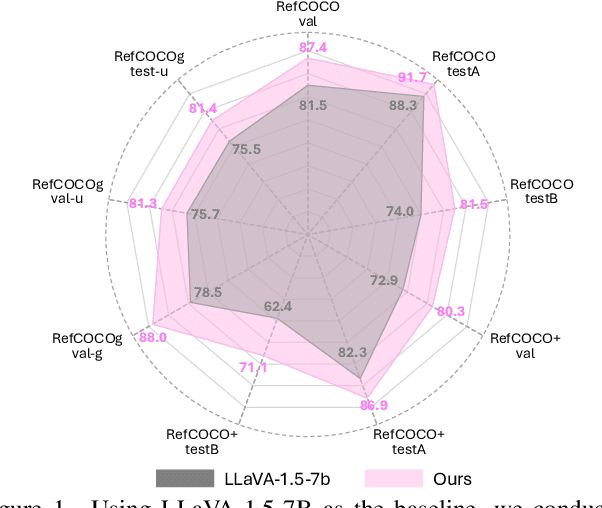
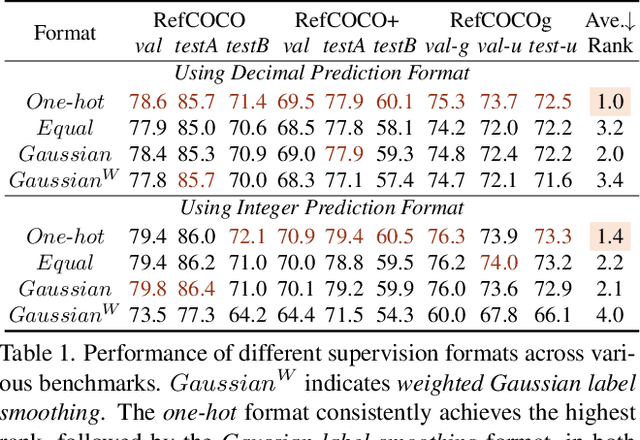
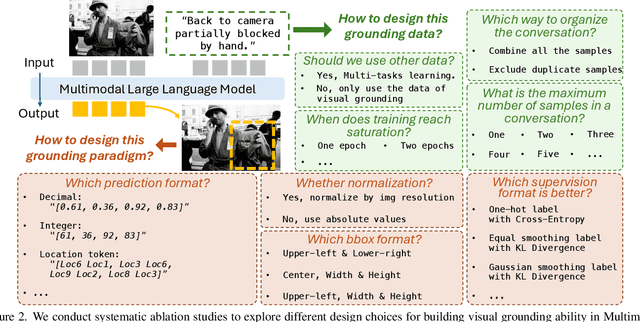
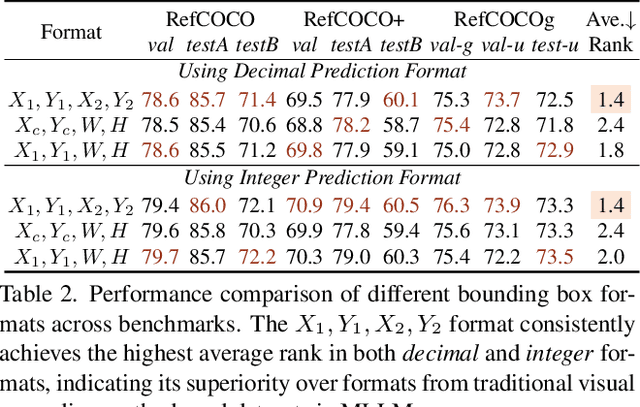
Abstract:Fine-grained multimodal capability in Multimodal Large Language Models (MLLMs) has emerged as a critical research direction, particularly for tackling the visual grounding (VG) problem. Despite the strong performance achieved by existing approaches, they often employ disparate design choices when fine-tuning MLLMs for VG, lacking systematic verification to support these designs. To bridge this gap, this paper presents a comprehensive study of various design choices that impact the VG performance of MLLMs. We conduct our analysis using LLaVA-1.5, which has been widely adopted in prior empirical studies of MLLMs. While more recent models exist, we follow this convention to ensure our findings remain broadly applicable and extendable to other architectures. We cover two key aspects: (1) exploring different visual grounding paradigms in MLLMs, identifying the most effective design, and providing our insights; and (2) conducting ablation studies on the design of grounding data to optimize MLLMs' fine-tuning for the VG task. Finally, our findings contribute to a stronger MLLM for VG, achieving improvements of +5.6% / +6.9% / +7.0% on RefCOCO/+/g over the LLaVA-1.5.
 Add to Chrome
Add to Chrome Add to Firefox
Add to Firefox Add to Edge
Add to Edge